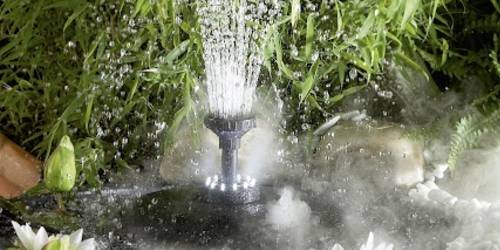IP protection classes and protection types
Published: August 12, 2021 | Reading time: 11 minutes
This text is machine translated.
When talking about IP or IP protection class, most people know that it has something to do with protection against moisture.
However, very few people know that the term IP protection class is not correct when looking at the exact designation.
This is because there is the IP protection type and there is the protection class. And both terms describe completely different properties of a product.
Electrical equipment such as lamps, electrical appliances, and installation materials must function reliably at all times. And under a wide variety of conditions.
For example, a garden light that is exposed to the weather all year round must be constructed and insulated very differently from a reading light that provides cozy lighting in a reading corner. In this case, even non-experts can see at first glance that the living room light is unlikely to withstand the harmful effects of a rain shower.
But even in industry and commerce, the requirements for electrical devices or high-voltage equipment vary greatly. While only harmless wood dust swirls around in a carpenter's workshop, technical equipment in commercial kitchens must be protected from greasy cooking fumes and in chemical factories perhaps from corrosive vapors.
In order to obtain a clear statement about the influences against which a product is protected, protection classes (International Protection Codes) have been introduced. Each category precisely defines the extent to which the unwanted ingress of foreign bodies and moisture into the interior of the device is prevented.
Protection against mechanical stress has also been precisely defined. This is important when housings or electrical equipment are installed in sports halls, for example, where they may be hit by balls. When used in public areas, this also includes intentional impacts or damage caused by vandalism.
What does IP mean?
The best-known protection class is the IP protection class (IP code), such as IP44. The abbreviation “IP” stands for “International Protection,” although the term “Ingress Protection” is often used in English.
What is IP classification?
The numbers following the abbreviation “IP” provide precise information about the influences against which a product is protected.
The combinations are precisely defined in the national and international standards DIN EN 60529 and ISO 20653 (for road vehicles) and indicate the type of protection in the different IP classes. The possible specifications range from IP00 to IP69 or IP6K9K.
The first code number or combination of numbers and letters indicates the degree of protection of the housing against contact. At the same time, this code number provides information about protection against foreign bodies. The definition of the individual numbers or combinations of numbers and letters can be found in the following table.
IP protection classes table
Even though the following table describes the IP protection type and not the IP protection class or IP class, it is often referred to as the IP protection class table. In this case, however, that is not a big deal. Even if people who are less technically savvy confuse the terms IP protection rating, IP protection class, or IP class, experts immediately know what is meant. This is because, in conjunction with the letters “IP,” it can only refer to protection against contact/foreign objects and water.
| First digit (ISO 20653) | First digit (DIN EN 60529) | Protection against contact | Protection against foreign objects |
|---|---|---|---|
| 0 | 0 | No protection | No protection |
| 1 | 1 | Protected against large-area contact (e.g., back of the hand) | Protected against large solid foreign objects (diameter ≥ 50 mm) |
| 2 | 2 | Protected against finger contact | Protected against medium-sized solid foreign objects (diameter ≥ 12 mm) |
| 3 | 3 | Protected against contact with tools and wires (diameter ≥ 2.5 mm) | Protected against small solid foreign objects (diameter ≥ 2.5 mm) |
| 4 | 4 | Protected against contact with tools and wires (diameter ≥ 1 mm) | Protected against granular solid foreign bodies (diameter ≥ 1 mm) |
| 5K | 5 | Complete touch protection | Protected against dust in harmful quantities (dust-protected) |
| 6K | 6 | Complete touch protection | Complete protection against dust ingress (dustproof) |
Note:
If a product has been classified according to DIN EN 60529 IP5X or IP6X, the two protection classes are designated according to ISO 20653 IP5KX and IP6KX.
The second digit or combination of digits/letters indicates the degree of protection provided by the enclosure against moisture or water ingress. Water protection is defined as follows:
| Second digit (ISO 20653) | Second digit (DIN EN 60529) | Protection against water |
|---|---|---|
| 0 | 0 | Kein Schutz |
| 1 | 1 | Protected against vertically falling water |
| 2 | 2 | Protected against dripping water falling at an angle (up to 15°) |
| 3 | 3 | Protected against spray water up to 60° from the vertical |
| 4 | 4 | Protected against splashing water from all directions |
| 4K | Protected against water jets from all directions with increased pressure | |
| 5 | 5 | Protected against water jets (nozzle) from any angle |
| 6 | 6 | Protected against powerful water jets |
| 6K | Protected against strong water jets under increased pressure | |
| 7 | 7 | Protected against temporary submersion |
| 8 | 8 | Protected from constant submersion |
| 9 | Protected against water during high-pressure/steam jet cleaning in agriculture | |
| 9K | Protected against water during high-pressure/steam jet cleaning for road vehicles |
Some examples of the most common IP protection classes:
What does IP20 mean?
If a product has IP20 protection, it has protection against contact with solid foreign objects larger than 12 mm (live components cannot be touched with a finger). There is no protection against water.
What does IP55 mean?
In addition to complete protection against contact (small amounts of dust may penetrate), a product with IP55 also offers protection against water jets from any angle.
What does IP44 mean?
A product with IP44 is protected against the ingress of solid foreign bodies larger than 1 mm and against splashing water from all directions.
What does IP65 mean?
A product with IP65 protection has complete protection against contact. Dust cannot penetrate and it is protected against water jets from any direction.
What does IP54 mean?
If a product has IP54 protection, it has complete protection against contact, although small amounts of dust may penetrate. It is also protected against splashing water from all directions.
What does IP67 mean?
Products with IP67 protection are touch-proof and dust-proof. They can also withstand temporary complete immersion in water. If permanent immersion is required, a product must have IP68 protection.
If one of the two digits is not to be specified or is not required for the IP protection class, an “X” is used instead of the digit.
The following overview table allows you to easily assign the most common protection classes to the respective performance characteristics. You can also see which protection class is required for specific operating conditions.
IP protection classes overview table
First digit >
| Protected against solid foreign objects (diameter ≥ 12 mm) | Protected against solid foreign objects (diameter ≥ 2.5 mm) | Protected against solid foreign objects (diameter ≥ 1.0 mm) | Protected against dust in harmful quantities (dust-protected) | Complete protection against dust ingress (dustproof) |
| No protection against water | IP 20 | IP 30 | IP 40 | IP 50 | IP 60 |
| Protection against vertically falling dripping water | IP 21 | IP 31 | IP 41 | IP 51 | IP 61 |
| Protection against dripping water falling at an angle of up to 15° | IP 22 | IP 32 | IP 42 | IP 52 | IP 62 |
| Protection against spray water up to 60° from the vertical | IP 23 | IP 33 | IP 43 | IP 53 | IP 63 |
| Protected against splashing water from all directions | IP 24 | IP 34 | IP 44 | IP 54 | IP 64 |
| Protected against water jets from any angle | IP 25 | IP 35 | IP 45 | IP 55 | IP 65 |
| Protected against powerful water jets | IP 26 | IP 36 | IP 46 | IP 56 | IP 66 |
| Protected against temporary submersion | IP 27 | IP 37 | IP 47 | IP 57 | IP 67 |
| Protected from constant submersion | IP 28 | IP 38 | IP 48 | IP 58 | IP 68 |
In dry indoor areas, protection against moisture plays a rather minor role. For this reason, lamps with IP20 can also be used here, which offer no protection against possible water ingress.
However, the situation is quite different in bathrooms. This is because moisture and splashing water are more likely to occur here. For this reason, DIN 57100/VDE 0100 Part 701 stipulates that luminaires installed in bathrooms must have protection classes IPX4, IPX5, or even IPX7, depending on the installation location.
The different protection classes in the bathroom.
(Image source: Paulmann Licht)
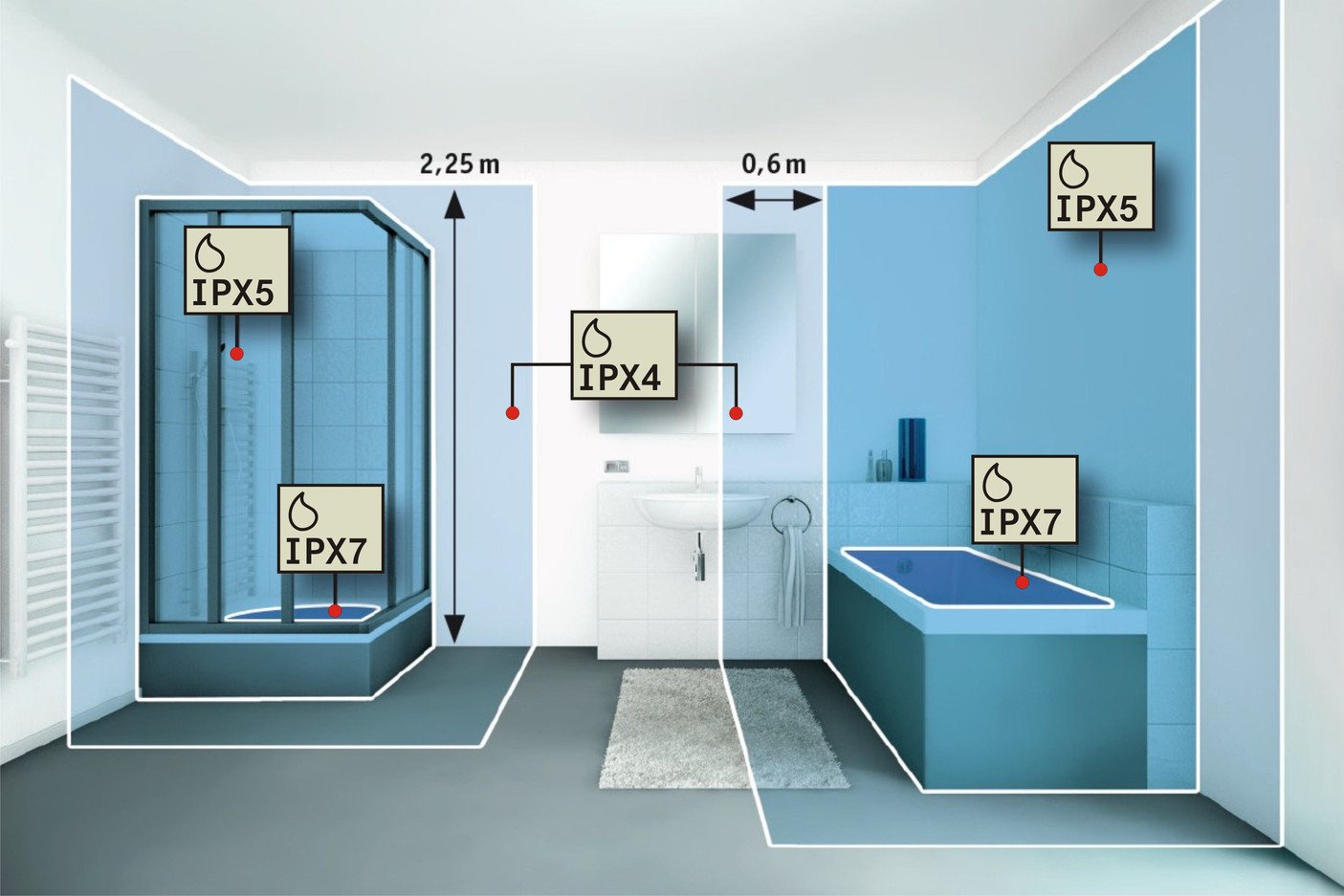


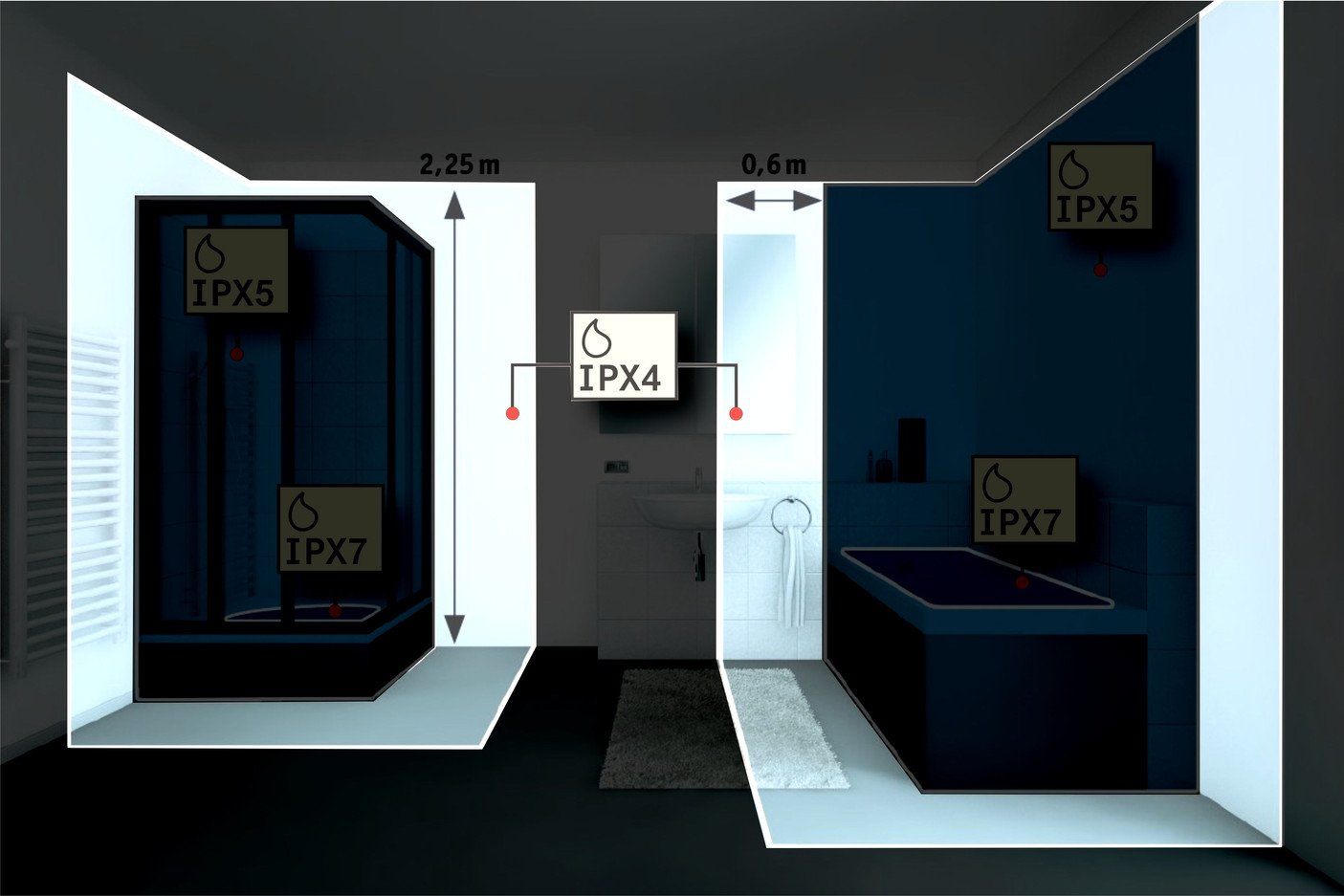

Lights in the shower or bathtub area (protection zone 0 with IPX7) may only be operated with a maximum operating voltage of 12 V/AC (alternating current) or 30 V/DC (direct current).
Above the shower or bathtub (protection zone 1 with IPX5), the lights may be operated with a maximum operating voltage of 25 V/AC or 60 V/DC.
When installing equipment or lamps outdoors, the installation location must be taken into account. This is because the degree of protection often does not need to be as high as initially assumed.
Installation in covered areas
If the installation location is under a roof, canopy, or balcony, for example, IP23 lamps are perfectly adequate. The roof reliably protects against splashing water from rain.
Mounting on the house wall
If lamps are mounted on the wall, it must be expected that they will be exposed to rain. In this case, products with IP44 are recommended. In addition to all-round splash protection, spiders and insects cannot nest in the lamp.
Path lighting in the garden
If the lights are directly exposed to the weather, the housings must have a protection rating of at least IP44.
Lighting for garden ponds and fountains
If lamps are used to illuminate garden ponds or fountains, they should have an IP67 rating. This ensures that the lamps are also protected against temporary immersion in water. If underwater spotlights are used, they must have an IP68 rating.
The different protection classes for outdoor use
(Image source: Paulmann Licht)
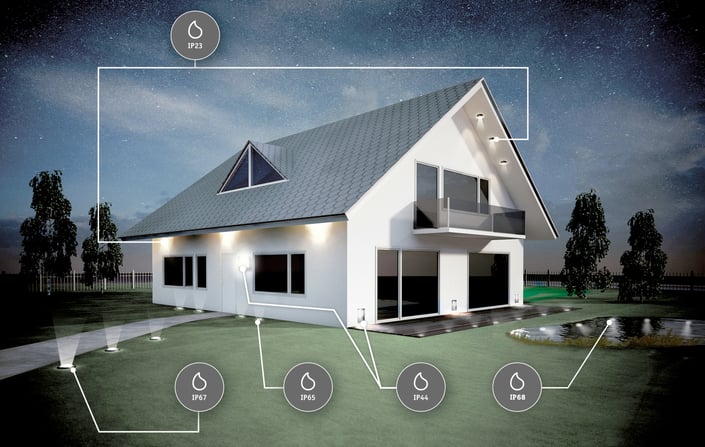

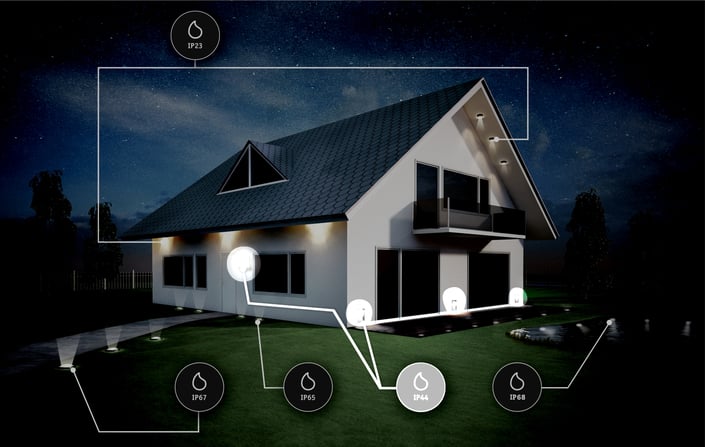


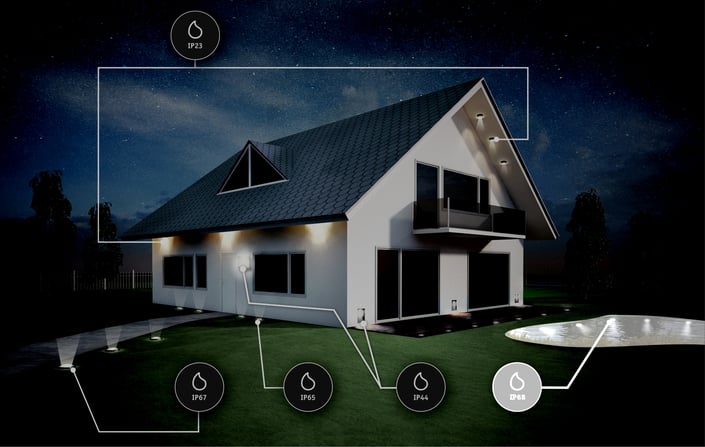
The IK protection class, or IK impact resistance rating, precisely defines the level of protection against external mechanical stress (impact stress). The IK code is internationally standardized in accordance with IEC 62262 and divided into 10 protection classes.
| Protection class | Impact energy |
|---|---|
| IK00 | No shock resistance |
| IK01 | Protected up to an impact energy of 0.14 joules |
| IK02 | Protected up to an impact energy of 0.20 joules |
| IK03 | Protected up to an impact energy of 0.35 joules |
| IK04 | Protected up to an impact energy of 0.50 joules |
| IK05 | Protected up to an impact energy of 0.7 joules |
| IK06 | Protected up to an impact energy of 1.0 joules |
| IK07 | Protected up to an impact energy of 2.0 joules |
| IK08 | Protected up to an impact energy of 5.0 joules |
| IK09 | Protected up to an impact energy of 10 joules |
| IK10 | Protected up to an impact energy of 20 joules |
Note:
One joule corresponds to the energy required to accelerate a body with a mass of 2 kilograms from rest to a speed of 1 m/s.
In electrical engineering, the protection class defines the safety measures taken to prevent electrical accidents caused by electric shock.
Particularly in the case of devices and equipment with metal housings, there is a high risk that the housing may become live in the event of a defect (insulation damage). Without the appropriate measures defined in the respective protection classes, this could lead to life-threatening situations.
The protection classes for all electrical equipment are specified in the EN 61140 and VDE 0140-1 standards. The symbols to be used to identify the equipment are defined in IEC 60417 (International Electrotechnical Commission).
Difference between protection type and protection class
While protection types define the degree of protection against contact, foreign objects, water, and mechanical stress, the protection class describes the measures that protect against dangerous voltages.
There are up to four protection classes, with protection classes I to III being the most important.
Protection class 0
Elektrische Betriebsmittel mit der Schutzklasse 0 verfügen lediglich über eine Basisisolierung. Da keine besonderen Schutzmaßnahmen gegen einen elektrischen Schlag vorhanden sind, muss der Schutz durch die Umgebung des Betriebsmittels sichergestellt werden. Eine Kennzeichnung ist nicht vorgesehen, darum gibt es auch keine Symbole für diese Schutzklasse. In der zukünftigen internationalen Norm ist die Schutzklasse 0 nicht mehr enthalten. Geräte mit dieser Schutzklasse sind in Deutschland und in Österreich nicht zulässig.
Protection class 1
Class I devices have protective earthing. This means that all electrically conductive parts of the housing are connected to the protective conductor system of the fixed electrical installation. This means that the housing parts are at earth potential. Portable devices in protection class I are equipped with a protective contact plug. If, in the event of a fault, a live conductor touches the housing connected to the protective conductor, a ground fault occurs. In this case, the circuit breaker (fuse) or residual current device (RCD) will trip and disconnect the device from the power supply.
Protection class 2
Class II devices have double or reinforced insulation between the active and accessible parts. Even if the devices have electrically conductive surfaces, these are not connected to the protective conductor. For this reason, two-pole contour plugs or Euro plugs without a protective contact are used for connection.
Protection class 3
Protection class III devices are operated with safety extra-low voltage (SELV) or protective extra-low voltage (PELV). The limit values for alternating current (AC) are ≤ 50V and for direct current (DC) ≤ 120V. Suitable voltage sources include rechargeable batteries (accumulators), batteries, or safety transformers.
